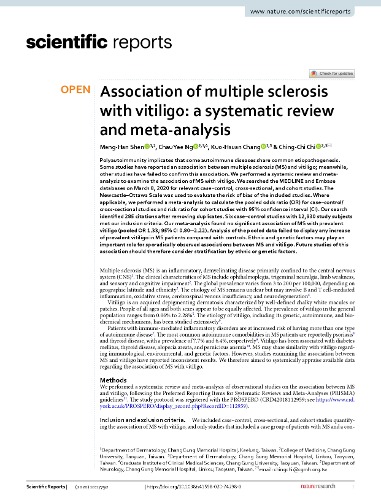研究動態
多發性硬化症與白斑症的關聯:系統性回顧

摘 要:
多自體免疫性意味著一些自體免疫性疾病共享相同的病因。一些研究報告了多發性硬化(MS)和白斑症之間的關聯性;同時,其他研究未能證實此關聯性。我們進行了一項系統性回顧和荟萃分析,以檢視MS與白斑症的關聯性。我們於2020年3月8日在MEDLINE和Embase數據庫中搜索了相關的病例-對照、橫斷面和群體研究。使用Newcastle-Ottawa Scale評估了包括在內的研究的偏倚風險。在適用的情況下,我們進行了荟萃分析,計算了病例-對照/橫斷面研究的總體勝算比(OR)和群體研究的風險比,並附帶95%的置信區間(CI)。我們的搜索在去除重複引文後識別了285個引文。符合我們的納入標準的有6個病例-對照研究,共有12,930名受試者。我們的荟萃分析發現,MS與既往的白斑症沒有顯著的關聯性(總體OR 1.33;95% CI 0.80‒2.22)。對總體數據的分析未顯示MS患者中既往白斑症的增加與對照組相比。族裔和基因因素可能對偶發觀察到的MS和白斑症之間的關聯性起重要作用。因此,將來的研究應該考慮按族裔或基因因素進行分層。Polyautoimmunity implicates that some autoimmune diseases share common etiopathogenesis. Some studies have reported an association between multiple sclerosis (MS) and vitiligo; meanwhile, other studies have failed to confirm this association. We performed a systemic review and meta-analysis to examine the association of MS with vitiligo. We searched the MEDLINE and Embase databases on March 8, 2020 for relevant case–control, cross-sectional, and cohort studies. The Newcastle–Ottawa Scale was used to evaluate the risk of bias of the included studies. Where applicable, we performed a meta-analysis to calculate the pooled odds ratio (OR) for case–control/cross-sectional studies and risk ratio for cohort studies with 95% confidence interval (CI). Our search identified 285 citations after removing duplicates. Six case–control studies with 12,930 study subjects met our inclusion criteria. Our meta-analysis found no significant association of MS with prevalent vitiligo (pooled OR 1.33; 95% CI 0.80‒2.22). Analysis of the pooled data failed to display any increase of prevalent vitiligo in MS patients compared with controls. Ethnic and genetic factors may play an important role for sporadically observed associations between MS and vitiligo. Future studies of this association should therefore consider stratification by ethnic or genetic factors.
近期研究動態
相關研究動態
- 先進皮膚成像系統在診斷面部色素性和炎症性疾病中的比較研究
- 從零到一:白斑症發病機理、診斷和治療的最新進展
- 皮膚間質液和血漿多重細胞因子分析顯示IFN-γ特徵及Granzyme B作為評估白斑症活動性、嚴重性和預後的有用生物標誌物
- 針對白斑症患者中升高的IFN-γ進行人類抗IFN-γ 單株抗體生物製劑治療可抑制對黑色素細胞的直接細胞毒性
- 致病性抗IFN-γ自身抗體通過阻礙受體組裝和介導的Fc反應起作用
- 口服氨甲環酸(TA)治療白斑症合併黃褐斑的可行性
- 穩定性白斑症表皮色素移植術與自動表皮微移植術的比較研究
- 穩定型分節型與非分節型白斑症患者的表皮色素移植療效和安全性
- 高細胞分辨率全視場人工智能輔助實時光學同調斷層掃描術在白斑症評估中的可行性:一項前瞻性縱向隨訪研究
- PCL 膠原蛋白增生劑誘發的白斑症

